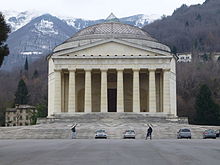Tempio Canoviano
This article needs additional citations for verification. (October 2014) |

The Tempio Canoviano or Temple of Canova is a
Roman Catholic parish church built in a severe Neoclassical style, based on the designs of Antonio Canova. It is located on a hilltop in Possagno in the Province of Treviso in the region of Veneto, Italy
.
Work on the temple, which is dedicated to the Holy Trinity, began on 11 July 1819

The atrium or
metopes
were carved by pupils from stucco casts of Canova.
The altars contain canvases from shuttered churches and monasteries including by Luca Giordano (St Francis of Paola); Palma il Giovane (Jesus in Gesthemane); Giovanni de Sacchis called il Pordenone (Madonna of the Mercies); and Andrea Vicentino (Saints Sebastian; Francis of Assisi, Roch, Anthony with the Madonna and child and a glory of angels). The bronze sculpture of the Pietà was completed by Bartolomeo Ferrari, based on models by Canova. Above the altar is a Deposition painted by Canova.[4]
References
- ^ "Duecento anni fa la posa della prima pietra del Tempio Canoviano di Possagno". www.finestresullarte.info (in Italian). Retrieved 2023-02-05.
- ISBN 978-3-930698-22-6.)
{{cite book}}: CS1 maint: multiple names: authors list (link - ISBN 978-0-230-36098-3.
- ^ "Tempio Canoviano di Possagno (chiesa parrocchiale)". Prolocopossagno.com. Retrieved 24 October 2014.
